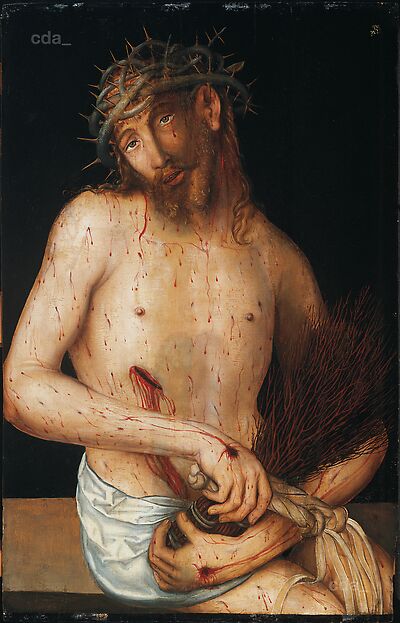- Attributions
-
Circle of Lucas Cranach the Younger
Workshop Lucas Cranach the Elder
Attributions
| Circle of Lucas Cranach the Younger | [Cat. Coburg 2018, no. 13, 80-83] |
| Workshop Lucas Cranach the Elder | [Restauro 2004] [Eble 2002] |
- Production date
- about 1540
Production date
| about 1540 | [Cat. Coburg 2018, no. 13, 80-83] |
- Dimensions
- Dimensions of support: 73.5 × 46.5 cm
Dimensions
Dimensions of support: 73.5 × 46.5 cm
[Bayerische Schlösserverwaltung, revised 2022]
Dimensions of support: 75 x 48 x 0.8 cm
[Cat. Coburg 2018, no. 13, 80-83]
- Signature / Dating
Artist's insignia upper right corner: serpent with dropped wings (genuine?)
Signature / Dating
Artist's insignia upper right corner: serpent with dropped wings (genuine?)
- Inscriptions and Labels
none Reverse: - brand mark, below the centre: 'E (with crown) // Cap. XI // No. 406'
(1. Location: …Inscriptions and Labels
Inscriptions, Badges:
none
Stamps, Seals, Labels:
Reverse: - brand mark, below the centre: 'E (with crown) // Cap. XI // No. 406'
(1. Location: Ehrenburg; 2. Object type: painting; accession number)
- three labels, top left: 'No. 108', centre: '23/8#, bttom left corner: 'Kap. XI 406 Ecce Homo v. Lucas Cranach'
- two similar stamps and inscription in chalk
- below the horizontal member, bottom right two identical stamps: 'Elemibehandlung durch Dr. Büttner'
Frame:
- lower member: brand mark with the inscription: 'Privat-Eigenthum Ernst II., Herzog v. S. Coburg-Gotha'
- beside this, stamp: 'Privat-Eigenthum' and the coat of arms of the duchy of Saxony-Coburg-Gotha
- bottom right corner: inventory label: 'Schloß Ehrenburg Coburg M. 414'
[Eble 2002, 21-23, 35, 36]
- Owner
- Bayerische Verwaltung der Schlösser, Gärten und Seen
- Repository
- Schloss Ehrenburg
- Location
- Coburg
- CDA ID
- DE_BSV-SE_CoE-G0082
- FR (1978) Nr.
- FR381H
- Persistent Link
- https://lucascranach.org/en/DE_BSV-SE_CoE-G0082/
